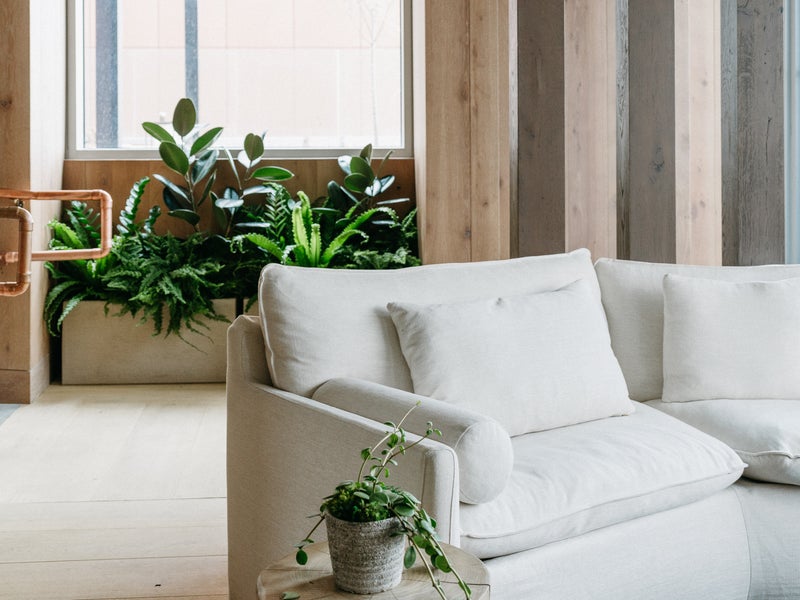Bring Nature into Your Space with These Easy Houseplant Tips and Tricks
From reduced stress to improved oxygen flow, the healing powers of nature are undeniable. With the help of 1 Hotel Toronto's Landscape Designer, Sharon Carlson of International Landscaping, we’re sharing tips to help you maintain thriving houseplants in your own home.

As a brand that does its best to honor nature in everything we do, we take great pride in blurring the lines between interior and exterior at our sanctuaries.
1 Hotel Toronto may be an urban oasis, but it’s no exception to our nature-centric design ethos. While you may see city skyline views when you look out your window, we’ve brought the outdoors in with thoughtful touches at every turn. With the help of Toronto’s International Landscaping Inc., we’ve arranged native plants in every room. This way, the healing powers of nature are the last thing you see before you drift off to sleep—and the first thing you wake up to in the morning.
To help you bring the same serenity into your spaces at home, we’re sharing tips from Sharon Carlson, the Landscape Development Designer who helped us bring our landscape and biophilic designs to life inside and outside of 1 Hotel Toronto.
Below, she lists some of the best plants for beginners, advice on how to help your plants grow faster, and general tips to ensure your houseplants continue to thrive.
Interview with Sharon Carlson of International Landscaping in Toronto, Canada
What are the best houseplants for beginners?
There are many great plant options for beginners. One of the first steps is to understand the environment; lighting can be an important consideration when picking out a plant. If you have pets or children, it may also be important to also check if the plants would be toxic to them, or ensure they are out of reach.
For sunny/bright rooms, here are some generally easy-care plants (south facing):
- Succulents
- Spider Plant
- Jade
- Money Plant
- Pothos
- Sansevieria
For low-light rooms, here are some generally easy-care options (north facing):
- Peperomia
- Pothos
- Haworthia
- Staghorn Fern
- Trailing Philodendron
- Peace Lily
- Cast Iron
- Kangaroo Fern
Any tips for making plants grow faster?
Using a soluble fertilizer or adding grow lights to your space can boost the growth of plants. When fertilizing, it’s good to check the needs of your specific plant, as they can vary. Over time, some plants can outgrow their pots, and their growth may become stunted or slow down, so carefully repotting them in a larger pot can sometimes be a solution. Some plants have delicate root structures and might not bounce back well from repotting, so check the recommendations for your specific plant type first. Similar to outdoor plants, indoor plants can have a growing and dormant season, so it can be good if you notice inconsistent growth patterns throughout the year. When your plants are putting out new leaves and growing, if you would like a more balanced plant structure, it can help to rotate them periodically so they get a more even distribution of the light.
How do you know how much water a plant needs?
Different plants have different water needs, so be sure to check the needs of your specific plant. Generally, overwatering can be more damaging than underwatering. When possible, it is best to have planters that have a drain hole in the base and use a saucer to catch any extra water. Bottom-watering can also be an effective method, where you set plants in a basin of water and they absorb from the base-up with capillary action, however this may not be possible depending on your pot type, so a good first step is to check the soil moisture and get into a watering routine. Depending on the light and temperature of your space, many plants can go about a week, sometimes two weeks between waterings. Often plants will start to tell you when they are thirsty, when their leaves start to droop.
Should you dust or cut the leaves of houseplants?
Dust can accumulate quickly in indoor environments. Gently wiping or washing the dust off the leaves will not only keep them looking fresh, it will also help the plants absorb more light and in turn keep them more healthy and resilient.
Are there ways to prepare your house plants for summer travel?
It depends on the length of your trip and how the timing falls within your watering routine. If you are away for about a week, it would be best to water before you go and when you return. For longer trips, it may be good to have a friend come check on your plants, or try using a self-watering system if possible. These are available at many gardening stores in various styles and sizes and can help maintain the soil moisture for a period of time.
Any other handy tips for a new house-plant parent?
Watch the leaves of the plants, they can often tell you a lot:
Drooping may mean overwatering.
Yellowing leaves may mean overwatering.
Thinning of the plant may mean not enough light.
Spots or webs may mean a pest or disease.
Brown tips may mean sun scorch.
Remember - each plant is unique, and even plants of the same species may grow differently in the same conditions. Just enjoy the process and keep learning as you go!












